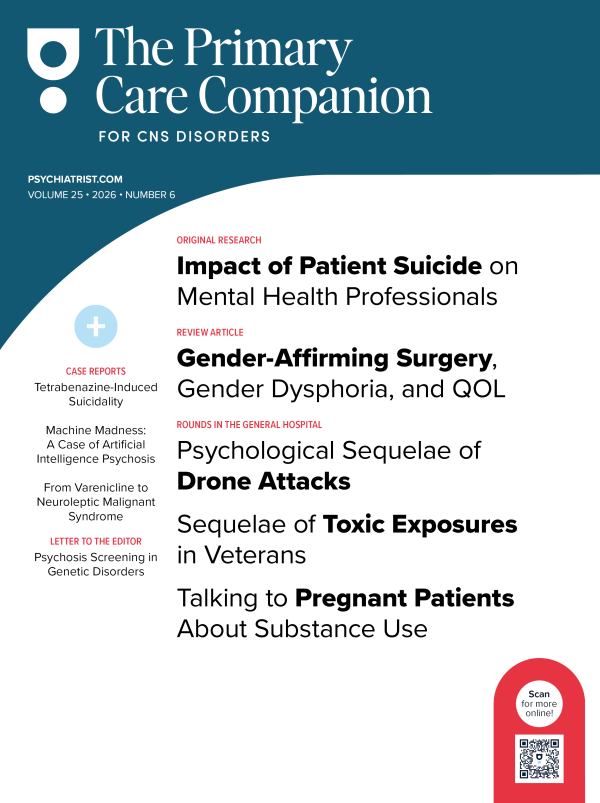Because this piece does not have an abstract, we have provided for your benefit the first 3 sentences of the full text.
To the Editor: On March 11, 2011, the Fukushima nuclear accident occurred in Japan, which resulted in the release of radioactive materials. Subsequently, information on the negative effects of radiation on the human body, including groundless rumors on the internet, ran rampant. Previous studies have shown positive associations between disaster media coverage (mostly television viewing) and psychological outcomes.
Obsessive-Compulsive Disorder in the Wake of the Fukushima Nuclear Accident: Anxiety and the Internet
To the Editor: On March 11, 2011, the Fukushima nuclear accident occurred in Japan, which resulted in the release of radioactive materials. Subsequently, information on the negative effects of radiation on the human body, including groundless rumors on the internet, ran rampant. Previous studies1 have shown positive associations between disaster media coverage (mostly television viewing) and psychological outcomes. However, no report on the association between obsessive-compulsive disorder (OCD) and disaster media coverage exists. We present the case of a young woman who developed OCD due to increasing anxiety about radiation contamination through gathering of information from the internet.
Case report. A 17-year-old female high school student developed obsessive-compulsive symptoms attributed to her fear of radiation contamination. She had no history of psychiatric or medical illness but had few friends and experienced childhood problems including difficulty maintaining eye contact since infancy, frequently playing alone, and limited interest in the world around her. She resided in an area approximately 93 miles southwest of the Fukushima site where, in 2011 after the accident, annual estimated air radiation did not exceed natural levels.2 After the nuclear accident, she persistently collected online information about radiation, spending many hours each day on this task. Her information gathering was biased, and she viewed only reports of progressive radiation contamination. She experienced increased anxiety, which fueled her desire to accumulate more information. Additionally, she became unable to eat domestic food and started to eat only nondomestic food. Due to her fear that her clothes had been contaminated with radiation, she started doing laundry until late at night. She avoided touching things without wearing gloves and eventually used over 100 pairs of gloves per day. As a consequence, she was unable to study for her university examinations. Her family brought her to our psychiatric outpatient practice approximately 5 months after the nuclear accident.
The patient had demonstrated characteristics of autism spectrum disorder beginning in infancy. However, because she functioned well at school and in everyday life prior to the nuclear accident, she had not received an autism spectrum disorder diagnosis. Because of her obsession with radiation contamination, we diagnosed her with OCD (DSM-IV criteria3). We suggested medication to treat her OCD symptoms, but she refused. We conducted cognitive-behavioral therapy with the patient and explained that her best option for preventing negative radiation effects was to focus on her studies and enter the university she wanted to attend, which was located far away from the nuclear power plant. She followed our advice, and her anxiety about radiation contamination was gradually reduced. Finally, her OCD symptoms and global functions improved.
In the present case, OCD most likely developed through the combination of characteristics pertaining to the nuclear disaster, autism spectrum disorder, and the internet. Being invisible, radiation can cause traumatic psychological effects in exposed individuals.4 For example, due to the knowledge of radiation effects on reproductive health, women are at risk for developing mental health-related issues.5 This knowledge could have increased the patient’s concerns about the nuclear accident. Furthermore, the internet allows for limitless, selective information gathering. At the time of the accident, the internet was flooded with baseless rumors, with "specialists" offering divergent opinions about effects of low-dose radiation on health. Such discrepancies would very likely cause further psychological distress in a person with characteristics of autism spectrum disorder, who tends to be vulnerable to contradictions. Additionally, the patient’s restricted interest may have caused her to select biased information, thus causing a vicious cycle wherein anxiety intensified with increasing information gathering. This anxiety interfered with her daily life and caused her to develop OCD. This case strikingly illustrates the strong anxiety that nuclear accidents can incite in people, as well as the state of anxiety in an internet society.
References
1. Pfefferbaum B, Newman E, Nelson SD, et al. Disaster media coverage and psychological outcomes: descriptive findings in the extant research. Curr Psychiatry Rep. 2014;16(9):464. PubMed doi:10.1007/s11920-014-0464-x
2. Monitoring Information of Environmental Radioactivity Level. Nuclear Regulation Authority Web site. http://radioactivity.nsr.go.jp/en. Updated May 20, 2015. Accessed November 17, 2015.
3. American Psychiatric Association. Diagnostic and Statistical Manual of Mental Disorders. Fourth Edition, Text Revision. Washington, DC: American Psychiatric Association; 2000.
4. Vyner HM. The psychological dimensions of health care for patients exposed to radiation and the other invisible environmental contaminants. Soc Sci Med. 1988;27(10):1097-1103. PubMed doi:10.1016/0277-9536(88)90304-8
5. Bromet EJ, Havenaar JM, Guey LT. A 25 year retrospective review of the psychological consequences of the Chernobyl accident. Clin Oncol (R Coll Radiol). 2011;23(4):297-305. PubMed doi:10.1016/j.clon.2011.01.501
aDepartment of Psychiatry, Jichi Medical University, Tochigi, Japan
bHospital Oyama Fujimidai, Tochigi, Japan
Potential conflicts of interest: None.
Funding/support: None.
Published online: April 6, 2017.
Patient consent: Permission was received from the patient to publish this case.
Prim Care Companion CNS Disord 2017;19(2):doi:10.4088/PCC.15l01910
https://doi.org/10.4088/PCC.15l01910
© Copyright 2017 Physicians Postgraduate Press, Inc.
Please sign in or purchase this PDF for $40.00.





